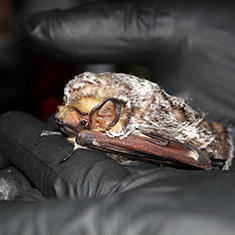
As wind energy development expands into new regions in the United States and abroad, reducing negative environmental impacts is critical. This includes reducing unanticipated bat fatalities at wind turbines. The Wind Wildlife Research Fund (WWRF) recently made an award to Bowman to lead a two-year project aimed at the conservation of a broad range of bat species.
Bowman is working with a team of experts to evaluate bat carcasses obtained from wind energy facilities to understand when and where to focus fatality reduction efforts. While they already know there are differences in collision risk among bat species, this study will assess if differences exist between males and females. The project will evaluate the sex ratios of bat fatalities at wind farms using genetics-based sex determination. This will help researchers understand when and where males and females of seven North American bat species experience peak collision risk to inform conservation efforts.
According to Sara Weaver, PhD, certified wildlife biologist®, and senior environmental manager at Bowman and the principal investigator for the study, “Bats are important insect predators, pollinators, and seed dispersers and are critical to maintaining ecosystem balance. This project will help fill a critical data gap in our knowledge on spatio-temporal patterns of wind-turbine related bat fatalities. If female bats are more susceptible to fatality in certain places or at particular times, then minimization strategies, such as slowing wind turbine blades when fatality risk is high, targeted at these times and locations, could reduce energy losses by reducing the frequency of curtailment while maintaining similar population-level effects for bats.”
Dr. Weaver is an industry expert involved in multiple studies evaluating methods to reduce wind energy-related bat fatalities.
Bowman’s study is one of three projects WWRF funded from a pool of 29 proposals. As the prime consultant, Bowman leads the project from inception through completion. Dr. Weaver refers to the research team as “… an all-star team of scientists.” Bowman is partnering with Dr. Todd Katzner with United States Geological Service, Dr. Sarah Fritts at Texas State University, Dr. Amanda Hale at Texas Christian University, and Dr. David Nelson at University of Maryland’s Center for Environmental Science. These researchers bring decades of expertise and experience in finding solutions to wind energy-related wildlife issues. Duke Energy Sustainable Solutions and Avangrid Renewables are industry partners who will be providing Bowman with data to support the project.
“The collaborative effort on this project between industry, academia, and Bowman strengthens our ability to find solutions to this unanticipated consequence of wind energy development, not only for the bats, but for the wind energy industry as well,” Weaver said. The Wind Wildlife Research Fund is an industry-led initiative that pools resources to advance collaborative, priority research to produce scientifically robust solutions that enable the continued expansion of wind energy while advancing wildlife conservation. The Fund is managed by the American Wind Wildlife Institute (AWWI).
Picture: Hoary bat (Lasiurus cinereus) provided by Dr. Cris Hein.



